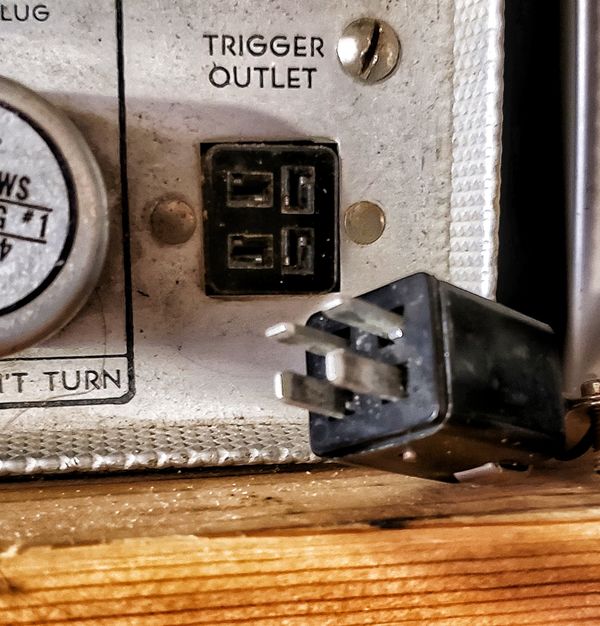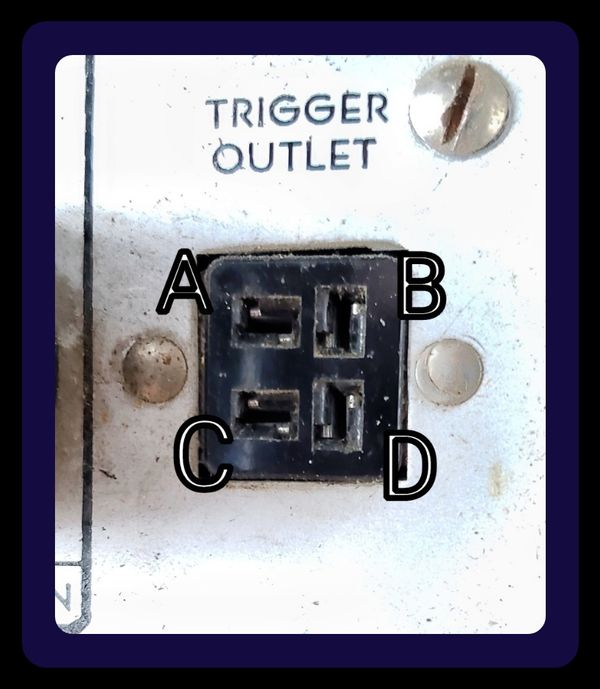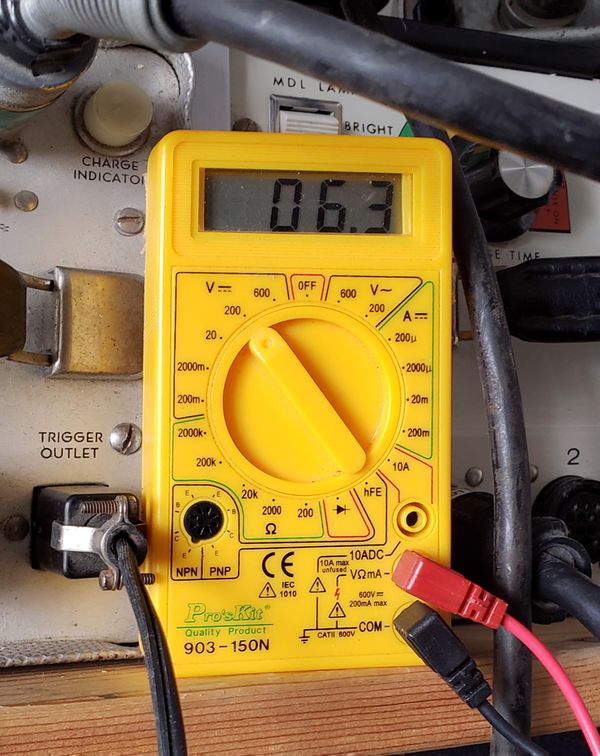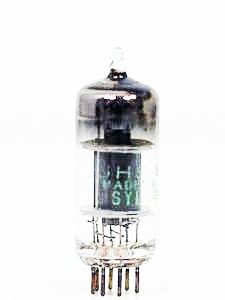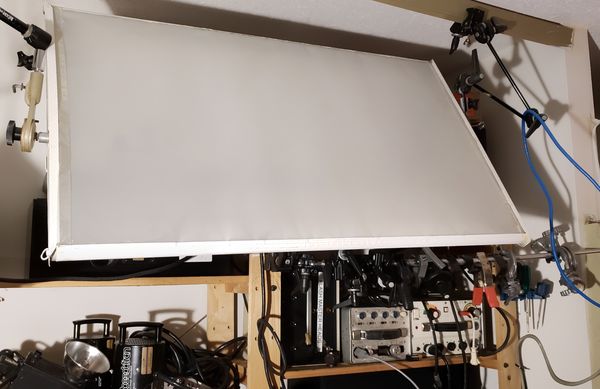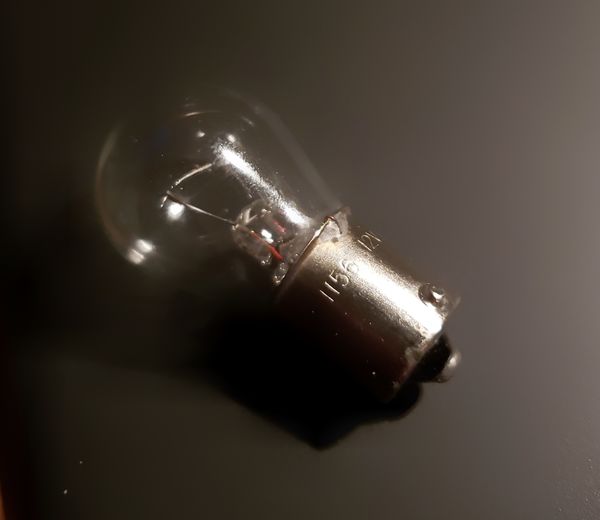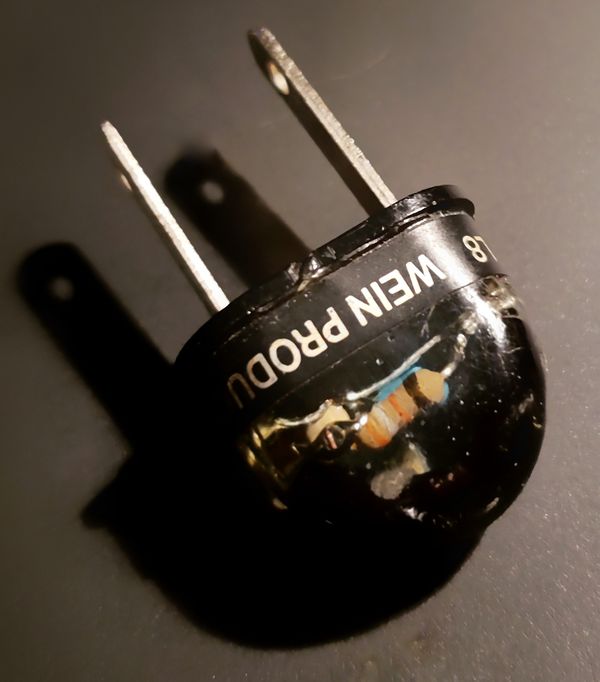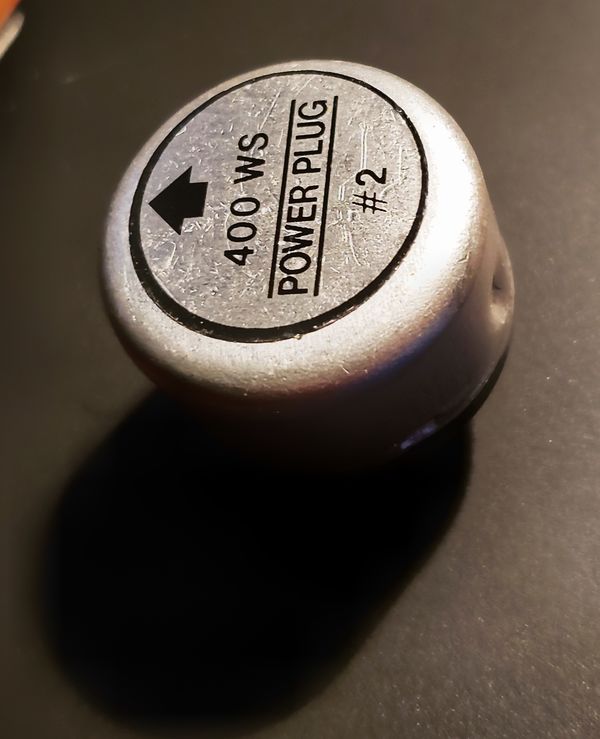Old Photogenic Flashmaster & 3 heads
Feb 8, 2019 23:13:41 #
Just picked up locally an ancient Photogenic AA01 400 Watt-second power supply
(supports 4 heads, each 100 Watt-second) and three flash heads:
* Model AA17L umbrella light
* Model AA11 "Speed-Lite" 11 1/2" reflector head
* Model AA11 "Speed-Lite" 11 1/2" reflector head with barn doors
Total price: $79.99. Everything seems to work. Had to replace the "ready" indicator lamp bulb
and modeling lamp bulbs.
The four-pin trigger cable is hard to find, so I'm thinking of onverting it to
1/4" tip ring connector used in later models. This model didn't have a built in
optical trigger, so that would be my goal .Man, this is solidly buillt: heavy stand,
heavy cables, heavy plugs.
Before I open it up, anybody know the pinouts on the 4-pin sync trigger jack?
Or what the generic part # for this 4-pin plug might be?
B&W used to sell one, but it's "no longer available".
https://www.bhphotovideo.com/c/product/42476-REG/Photogenic_903488_Female_HH_to_Photogenic.html
(supports 4 heads, each 100 Watt-second) and three flash heads:
* Model AA17L umbrella light
* Model AA11 "Speed-Lite" 11 1/2" reflector head
* Model AA11 "Speed-Lite" 11 1/2" reflector head with barn doors
Total price: $79.99. Everything seems to work. Had to replace the "ready" indicator lamp bulb
and modeling lamp bulbs.
The four-pin trigger cable is hard to find, so I'm thinking of onverting it to
1/4" tip ring connector used in later models. This model didn't have a built in
optical trigger, so that would be my goal .Man, this is solidly buillt: heavy stand,
heavy cables, heavy plugs.
Before I open it up, anybody know the pinouts on the 4-pin sync trigger jack?
Or what the generic part # for this 4-pin plug might be?
B&W used to sell one, but it's "no longer available".
https://www.bhphotovideo.com/c/product/42476-REG/Photogenic_903488_Female_HH_to_Photogenic.html
Feb 8, 2019 23:36:45 #
I had one of those as my first set of studio lights, it's a nice set. I can't help with your question though.
Feb 9, 2019 00:16:11 #
I think you should be able to use a volt meter to check which pin(s) have voltage and which pins are the ground wire. I gave mine away about a year ago or I'd figure it out for you... I'm not sure what the potential for damage is but you should be able to short the voltage pin to the ground and see if it triggers the strobes. I was able to use a Yongnuo flash trigger to operate the pack, it tested at 10 volts which was the upper limit of the triggers
There was an optical trigger that you could plug into the pack. Also, depending on the "power plug" you have you may be able to turn it around and get different power levels to the flash heads. I had a couple different plugs that did 100/100/50/50 to the ports as well as 100 to all or 50 to all. Lots of fun to play with.
Here's an optical slave I just found on ebay: http://www.ebay.com/itm/Photogenic-8050PSA-Slave-For-Flashmaster-AA01-AA01A-packs-converted-solid-state/312467614509?hash=item48c0856b2d:g:2dYAAOSwPaBcXjE~:rk:17:pf:0
There was an optical trigger that you could plug into the pack. Also, depending on the "power plug" you have you may be able to turn it around and get different power levels to the flash heads. I had a couple different plugs that did 100/100/50/50 to the ports as well as 100 to all or 50 to all. Lots of fun to play with.
Here's an optical slave I just found on ebay: http://www.ebay.com/itm/Photogenic-8050PSA-Slave-For-Flashmaster-AA01-AA01A-packs-converted-solid-state/312467614509?hash=item48c0856b2d:g:2dYAAOSwPaBcXjE~:rk:17:pf:0
Feb 9, 2019 07:32:04 #
Thye male connector on you Flashmaster power supply is made by Cinch-Jones. There are hundreds of configurations and they are all carried by the following:
www.electronicsurplus.com
www.newark.com
Contact one of theses suppliers with a picture of the connector or the model number (sometimes it appears on the plastic part that retains the pins) and I am sure you can locate the part.
They are easy enough to wire up and there is no high voltage at the synch socket so you will be able to find which 2 pins are the ones to connect to. Ordinary lamp cord with a standard household female at the other end will connect to a standard synch cord. You will be making one just like the discontinued model in the B&H ad.
I have repaired dozens of those units and the are virtually indestructible. It is not advisable to get into the innards of that power pack unless you have experience with them. Depending on the model year, it coud be very difficult to remove the old socket- they are attached with rivets, not screws and are very close to some high voltage connections. Some of them had a safety switch/wire wound resistor circuit that automatically drains and discharges the capacitors when the chassis is lifted from the case. Problem is, it is sometimes difficult to put back and reset if it is disturbed- it could jam or break off and that part would be difficult to find and replace.
The trigger voltage is under 10 Volts- mine reads 8.5
Also, sometimes some of the fiber spacers between the chassis and the cabinet dry up and consequently flake off if lifted. Again, they are difficult to find and replace and if the are removed the unit will buzz each time it recycles. The circuit predates solid state voltage multipliers and uses a transformer- thus the buzz. Not to be confused with the buzzer alarm that sound if one of the lamp heads misfires- each outlet has a switch to turn that feature on or off.
The lamp you replaced is a telltale light- it lights up as the unit recycles and extinguishes when it is up to power.
Those connector avera about $8.00.
I wonder of the unit came with additional power buttons- those little metal caps with the ratio indications. There are dozens of various power distribution options.
The umbrella head is great! It has a 250 watt modeling lamp and you can see you lighting patterns. The modeling lamps in the othere lamp heads are 12 volt tail light lamps- easily replaceable. If you find the a bit dim, there is an aircraft lamp that fits those sockets that are significantly brighter.
You got a good deal at that price. If the unit needs flash tube replacements or major repairs contact Holly Enterprises at- hollyflas.com or 800-988-7111) The are the folks to see about vintage Photogenic gear.If the aforementioned suppliers don't have that plug, Holly will probably have it. BTW- If you unit came with a synch cord, there is no need to replace it unless it is damaged or missing. The plugs hardly ever break and the don't carbonize or arc because there is no high voltage.
www.electronicsurplus.com
www.newark.com
Contact one of theses suppliers with a picture of the connector or the model number (sometimes it appears on the plastic part that retains the pins) and I am sure you can locate the part.
They are easy enough to wire up and there is no high voltage at the synch socket so you will be able to find which 2 pins are the ones to connect to. Ordinary lamp cord with a standard household female at the other end will connect to a standard synch cord. You will be making one just like the discontinued model in the B&H ad.
I have repaired dozens of those units and the are virtually indestructible. It is not advisable to get into the innards of that power pack unless you have experience with them. Depending on the model year, it coud be very difficult to remove the old socket- they are attached with rivets, not screws and are very close to some high voltage connections. Some of them had a safety switch/wire wound resistor circuit that automatically drains and discharges the capacitors when the chassis is lifted from the case. Problem is, it is sometimes difficult to put back and reset if it is disturbed- it could jam or break off and that part would be difficult to find and replace.
The trigger voltage is under 10 Volts- mine reads 8.5
Also, sometimes some of the fiber spacers between the chassis and the cabinet dry up and consequently flake off if lifted. Again, they are difficult to find and replace and if the are removed the unit will buzz each time it recycles. The circuit predates solid state voltage multipliers and uses a transformer- thus the buzz. Not to be confused with the buzzer alarm that sound if one of the lamp heads misfires- each outlet has a switch to turn that feature on or off.
The lamp you replaced is a telltale light- it lights up as the unit recycles and extinguishes when it is up to power.
Those connector avera about $8.00.
I wonder of the unit came with additional power buttons- those little metal caps with the ratio indications. There are dozens of various power distribution options.
The umbrella head is great! It has a 250 watt modeling lamp and you can see you lighting patterns. The modeling lamps in the othere lamp heads are 12 volt tail light lamps- easily replaceable. If you find the a bit dim, there is an aircraft lamp that fits those sockets that are significantly brighter.
You got a good deal at that price. If the unit needs flash tube replacements or major repairs contact Holly Enterprises at- hollyflas.com or 800-988-7111) The are the folks to see about vintage Photogenic gear.If the aforementioned suppliers don't have that plug, Holly will probably have it. BTW- If you unit came with a synch cord, there is no need to replace it unless it is damaged or missing. The plugs hardly ever break and the don't carbonize or arc because there is no high voltage.
Feb 9, 2019 17:58:16 #
E.L.. Shapiro wrote:
Thye male connector on you Flashmaster power suppl... (show quote)
That photo looks identical to my unit!
Cinch-Jones was the clue I needed on the connector. Thanks!
Incredibly, Cinch is still in business and the plug is still in production:
Jones P-304-CCT (with 180 degree cable clamp)
This Model AA01 unit is so old it has a vacuum tube trigger! A 2D21 gas thyratron.
So not surprisingly, the trigger is high voltage. I measured 407 VDC between
two of the pins and 387 VDC between the other two. Sure wish I new why
there are two circuits in the trigger connector.
Apparently the later model AA01-A had a solid state trigger: a Silicon Control Rectifier.
As you said, it was lower voltage.
So far, I haven't been able to locate documentation on the trigger jack pinouts or a
schematic diagram for this unit. I did find the User's Manual and Parts List, which
originally contained the schematic, but the schematic is missing from the the scan:
https://www.butkus.org/chinon/flashes_meters/photogenic_machine_company/electronic_flashmaster/electronic_flashmaster.htm
Anyway, looks like I'll need something like a Paramount voltage limiter cord
or Wein SafeSync. I have a SafeSync, but need it for old HV speedlites. (After
all these years, synch voltage still isn't standardized. High voltage is gone, but
anything from 5 to 12 VDC is common.)
I may just wire up a relay with 4 AA batteries (for 6 volts). That will operate a
Wein L-8 optical trigger. I'll just need a diode to damp the self-inductance on the
relay coil. A relay really does give better isolation than a solid state circuit.
It only came with one "power button": four x 100 W-s or four x 50 W-s.
Interesting that the ready lamp is an "unready" lamp! But I guess that means
it's not on as much, saving the bulb. It sure charges fast!
I cleaned it up and it looks new. Funny how stuff made of metal lasts.
It was made in Youngstown, OH. The power supply and umbrella light
rolls around on the casters quite easily--I'm not used to so much convenience!
The voltage regulation is really nice, since we're on a generator here
much of the time.
The later models added a solid-state SCR trigger, more power (600 W-s)
and a few new features (5th head, test button, plug-in optical trigger), but
are otherwise similar. They also went to a square power plug: the one I
have is round, like a vacuum tube base.
Whenever I get a new piece of equipment, I always write up my own "cheat
sheet" with what I need to remember to use it, and serial numbers. I'm working
on that now.
Feb 10, 2019 16:28:50 #
I have this particular unit operating since about 1975. I am not certain if this model has the thyratron tube in the trigger circuit but I did some voltage readings on the trigger outlet to verify voltages and polarity. Please see the attached diagram of the trigger outlet.
A and C are the terminals that I have my synch cord or radio-slaves connected to. Polarity: B is the (+) and C is the (-). The voltage on that combination is 6.3 DCV. This combination works reliably with hard wire, radio slaves and ordinarily photoelectric cells like the "cat's eyes" made by Wein. The original synch cord that was supplied with the unit is wired for this configuration.
A and C. will also trigger the unit, however, the voltage reading there is 198 VDC. I have never attached anything to this combination. It may have been intended for an early plug-in model of Photogenic's photoelectric cell which had no built-in solid state circuitry and may have required a higher voltage to operate.
This unit has never required repairs except for tightening a few external screws so I never removed the chassis from the case. Assuming it has the original trigger circuitry, it is probably the same as yours. A later model that I still use, was repaired some year ago and I replaced the trigger circuit with a solid state version. I no longer have a supply of replacement thyratron tubes and I could not find a current source of supply. Years ago, those tubes were used in the Graflex Stroboflash models, the Photogenic Strudomaster line and the Starlighter (Ascor) studio units.
On my older units, I routinely use the Wein Safe-Synch, if they are directly connected to any digital camera.
I thought these voltage measurements may be useful to you and I am sure you will verify them before connecting your new acquisition to a digital camera.
A and C are the terminals that I have my synch cord or radio-slaves connected to. Polarity: B is the (+) and C is the (-). The voltage on that combination is 6.3 DCV. This combination works reliably with hard wire, radio slaves and ordinarily photoelectric cells like the "cat's eyes" made by Wein. The original synch cord that was supplied with the unit is wired for this configuration.
A and C. will also trigger the unit, however, the voltage reading there is 198 VDC. I have never attached anything to this combination. It may have been intended for an early plug-in model of Photogenic's photoelectric cell which had no built-in solid state circuitry and may have required a higher voltage to operate.
This unit has never required repairs except for tightening a few external screws so I never removed the chassis from the case. Assuming it has the original trigger circuitry, it is probably the same as yours. A later model that I still use, was repaired some year ago and I replaced the trigger circuit with a solid state version. I no longer have a supply of replacement thyratron tubes and I could not find a current source of supply. Years ago, those tubes were used in the Graflex Stroboflash models, the Photogenic Strudomaster line and the Starlighter (Ascor) studio units.
On my older units, I routinely use the Wein Safe-Synch, if they are directly connected to any digital camera.
I thought these voltage measurements may be useful to you and I am sure you will verify them before connecting your new acquisition to a digital camera.
Feb 10, 2019 20:46:03 #
E.L.. Shapiro wrote:
I have this particular unit operating since about ... (show quote)
Shorting B to C triggers my unit as well. I measure 12.1 VDC between B(+) and C(-).
Looks the modeling lamps are 12V as well---looks like they changed from 6.3V to 12V
at some point.
The reason for the four connector plug is that the model AA01 accepted the model
8050PS phototube trigger! It may have needed a grid heater. Apparently it's
different from the 8050PSA solid-state optical slave that plugged into the later
AA01-A (or AA01 that had been converted to SCR solid-state trigger circuit).
It would be interesting to know more -- but I haven't found doc on either one.
I did see some 8050PSA solid-state optical slaves. offered for sale.
I was having trouble with the modeling lights all not coming on sometimes.
Turned out to be dust in the "Modeling Lights" switch. I took it apart, cleaned
it and burnished the contacts, and now it's working. Guess I'll keep a dust cover
over it when not in use.
2D21 thyratron tube appears to be available from Newark and a couple of .coms,
as well as eBay:
https://www.newark.com/richardson-electronics/2d21/electron-tube/dp/05F9500
https://www.thetubestore.com/2d21-pl21-5727
https://www.electrontubestore.com/index.php?main_page=product_info&products_id=424
https://www.ebay.com/b/2d21-Tube/64627/bn_7023252295
Everything works now. I couldn't be more pleased. The modeling light on the
umbrella is nice and bright (but also has a "Low" setting). I think this set up
will work well with my old Paul C Buff "White Lightening" monolight, which
has a built-in optical trigger. I've modified the Buff to accept a barn door or a snoot.
Next step is to rig up an optical trigger. I'm going to try a Wein L8 (W940050)
Micro Slave which is the H-style (household) connector. To be on the safe side,
I'm going to plug it into a Wein SSH (W990500) Safe-Sync (H-style household
plug in and out). That way, I won't risk burning out the L8 if the voltage spikes.
And I've ordered the Cinch Jones plug (P-304-CCT). I think I may leave 10 ft of
cable, in case I need to move the sensor closer to the camera flash.
I'm very impressed with the construction on this unit. How does it compare with
your newer Photogenic units? Has anybody tried the newer flash gear from Photogenic?
Feb 10, 2019 23:38:12 #
Older Photogenic equipment gives new meaning to the old adage "They don't make 'em like they used to anymore"! I don't believe there is anything in an electronic flash line, being currently produced, that will prove that kind of longevity. They were manufactured with high quality domestically made components, there were lots of points to point wiring, most of the resistors were over-rated and "gold" tolerance, and the all over construction was straightforward and durable. Some of the connectors are "Mil-Spec". They have been my go-to brand since the late 1950s when I began my apprenticeship in professional portraiture. That even predated electronic flash. The first studio I worked in had 3200K tungsten units made by the Photogenic Machine Company at Youngstown Ohio- they were literally made of iron! There were eventually replaced by a complete set of Studiomasters.
The Flashmasters were my first studio and location setup. When I opened my first studio in 1972, I purchase a complete up-to-date set of Studiomasters, plus an 800 w.s Skylighter. Most of those units are still operational, however, the pushbutton power selector assemblies are no longer available.
The Photogenic gear is the only system that was specifically designed for gor portraiture. Although the are powerful enough, the coud be powered down sufficintly to enable wider aperture for selective focus and use with soft-focus lenses. The parabolic reflector designs are very compatible with light feathering techniques. There are special reflectors for background lighting, lamp heads with Fresnel spotlight configurations, and the Boommaster unit which is specially designed for hair lighting. The make many useful snoots, grids, and barn doors as well. Many of the interchangeable reflectors and accessories are compatible with both Flashmaster and Studiomaster lines. All my old accessories fit on my current Powerlight models. All the 16" parabolic, pan reflectors (AKA beauty dishes) and other specialized reflectors that I invested in 40 years ago are still in use.
I now use 3 Photogenic Powerlights in addition to some of my older gear. The earlier models were still made of metals but the current ones use more plastics. They do work well but I doubt if the will last quite as long as the older units. The company has changed hands and I don't think engineering has the same integrity. I am not a big fan of LCD readouts and push-button adjustments on flash gear- I like good old fashion toggle and rotary switches on lighting gear- they're faster and more repeatable. The new gear is not as positive and durable.
Photogenic did enter the "commercial" lighting market with a few higher powered units. I have an 800 w.s unit hooked up to an Aurora Lamp head-it's like a smaller version of the Skylighter. I use it as a general fill source for portraiture. Somehow these units did not market well and were soon discontinued. Mine has been working reliably for 15 years.
Your power pack and the heads do not tend to pick up too much dust and dirt in a relatively clean environment. Now that you and out that switch, it will probably function well for another 50 years.
If you are already into the innards, there is an adjustment at the bottom of the chassis that will enable brighter output for the 12 Volt lamps.
If you can find a 400 w.s power plug, it works especially well with the umbrella light.
The Wein Micro-Slaves are great- they will trigger any flash unit, regardless of trigger voltage and they are quite sensitive. If you connect one to the synch cord and keep it near the ceiling, even a small bounced Speedlight will set it off. The Buff radio slaves will function well with your unit and they are relatively inexpensive.
The Flashmasters were my first studio and location setup. When I opened my first studio in 1972, I purchase a complete up-to-date set of Studiomasters, plus an 800 w.s Skylighter. Most of those units are still operational, however, the pushbutton power selector assemblies are no longer available.
The Photogenic gear is the only system that was specifically designed for gor portraiture. Although the are powerful enough, the coud be powered down sufficintly to enable wider aperture for selective focus and use with soft-focus lenses. The parabolic reflector designs are very compatible with light feathering techniques. There are special reflectors for background lighting, lamp heads with Fresnel spotlight configurations, and the Boommaster unit which is specially designed for hair lighting. The make many useful snoots, grids, and barn doors as well. Many of the interchangeable reflectors and accessories are compatible with both Flashmaster and Studiomaster lines. All my old accessories fit on my current Powerlight models. All the 16" parabolic, pan reflectors (AKA beauty dishes) and other specialized reflectors that I invested in 40 years ago are still in use.
I now use 3 Photogenic Powerlights in addition to some of my older gear. The earlier models were still made of metals but the current ones use more plastics. They do work well but I doubt if the will last quite as long as the older units. The company has changed hands and I don't think engineering has the same integrity. I am not a big fan of LCD readouts and push-button adjustments on flash gear- I like good old fashion toggle and rotary switches on lighting gear- they're faster and more repeatable. The new gear is not as positive and durable.
Photogenic did enter the "commercial" lighting market with a few higher powered units. I have an 800 w.s unit hooked up to an Aurora Lamp head-it's like a smaller version of the Skylighter. I use it as a general fill source for portraiture. Somehow these units did not market well and were soon discontinued. Mine has been working reliably for 15 years.
Your power pack and the heads do not tend to pick up too much dust and dirt in a relatively clean environment. Now that you and out that switch, it will probably function well for another 50 years.
If you are already into the innards, there is an adjustment at the bottom of the chassis that will enable brighter output for the 12 Volt lamps.
If you can find a 400 w.s power plug, it works especially well with the umbrella light.
The Wein Micro-Slaves are great- they will trigger any flash unit, regardless of trigger voltage and they are quite sensitive. If you connect one to the synch cord and keep it near the ceiling, even a small bounced Speedlight will set it off. The Buff radio slaves will function well with your unit and they are relatively inexpensive.
Feb 11, 2019 01:43:08 #
Bipod wrote:
Shorting B to C triggers my unit as well. I measu... (show quote)
Fwiw, the yongnuo rf603 wireless triggers work great with the photogenic pack, are cheap and you don’t need to run any cables. You can certainly go the optical route but it’ll cost more and anyone else with a flash will be triggering your lights.
http://www.amazon.com/YONGNUO-RF-603C-II-C3-Wireless-Remote-Trigger/dp/B00JVEXRE2/ref=sr_1_1_sspa?ie=UTF8&qid=1549867176&sr=8-1-spons&keywords=yongnuo+rf603c+ii&psc=1&smid=AMIHU7JS0U6DA
Feb 11, 2019 06:36:45 #
E.L.. Shapiro wrote:
Older Photogenic equipment gives new meaning to th... (show quote)
Wow, you really have a lot of history with Photogenic. They must have sold thousands of these units
(and even more heads) because I've seen a lot of them around.
Inside, the Flashmaster reminds me of defense electronics from that era (except that it doesn't
have the coating of anti-fungal varnish). It's so nice to see wires all color-coded and
neatly bundled (by hand) into cables. Every board is accessible just by removing screws.
Just to be on the safe side, I cleaned all the connectors and all the spade lugs in the entire system
with contact cleaner. But I didn't see any corrosion except a bit of rust on the retainer spring for
the 2D21 tube. Whoever owned it, didn't keep it near a darkroom. Now that it's been cleaned,
it basically looks brand new, inside and out.
I'm with you on disliking menus and LCD or LED displays. Really hard to tell at a glance what's
on and off (important with flash heads). And digital has three states: 0, 1, and broken. And when
it breaks, it's like Humpty Dumpty (especially the surface mount and multi-layer boards--almost
nobody attempts board-level repairs anymore).
I ordered four used power plugs, including the 400 x 1 (2) and 200 x1 & 100 x 2 (#3).
I'm still going to try to get ahold of the Flashmaster schematic if I can, for future reference.
It's good to know the Wein L8 is sensitive and are voltage tolerant. I'll still use the Safe-Sync,
since I may want to plug it into a camera. This trigger input is connected to a grid in the 2D21
tube. (They only pull it up to +12VDC but potentially it could see the plate voltage if something
goes wrong.). I already have a household to standard sync adapter to get from the Wein Safe-Sync
to the camera's X jack.
Some of these optical slaves will trigger even with a black IR filter over the camera flash.
That's really handy if you don't want on camera-flash screwing up your photo.
I have been thinking about replacing my wireless. I have Cactus V4 -- not the the most physically
sturdy. I know from wireless mics and guitar systems that it's hard to find a wireless that works
around cables and lighting equipment. Seems like there are always dead spots on stage, or the
wireless starts to get flakey as the batteries run down.
Well, this has been my most enjoyable used equipment experience in a long time. Thanks for
your good help!
Feb 11, 2019 07:05:06 #
sloscheider wrote:
Fwiw, the yongnuo rf603 wireless triggers work great with the photogenic pack, are cheap and you don’t need to run any cables. You can certainly go the optical route but it’ll cost more and anyone else with a flash will be triggering your lights.
http://www.amazon.com/YONGNUO-RF-603C-II-C3-Wireless-Remote-Trigger/dp/B00JVEXRE2/ref=sr_1_1_sspa?ie=UTF8&qid=1549867176&sr=8-1-spons&keywords=yongnuo+rf603c+ii&psc=1&smid=AMIHU7JS0U6DA
http://www.amazon.com/YONGNUO-RF-603C-II-C3-Wireless-Remote-Trigger/dp/B00JVEXRE2/ref=sr_1_1_sspa?ie=UTF8&qid=1549867176&sr=8-1-spons&keywords=yongnuo+rf603c+ii&psc=1&smid=AMIHU7JS0U6DA
That's good to know about, thanks!
For cameras that only flash once per exposure (or can be configured to do so),
I prefer optical trigger. Expecting wireless to work indoors in a room full of
electrical equipment with wiring in the walls is asking a lot.
You can buy wireless chip sets, but for the gadgets to actually work, the whole
system -- protocol, encoding, antenna, etc. -- has to be carefully designed by
somebody who knows radio (not your average EE).
Most of this units are separate transmitters and receivers, so there's no way for the
receiver to respond with a NAK if a transmission is garbled or if its unable to comply.
If I build a wireless set, I'd put a photocell in the transmitter so it could tell if there
was no flash and re-try. But then, how many times do you re-try? And what if it's
triggering more than one flash?
No, bright light interference is much less common than RF interference--and easier
to notice. That makes it easier to figure out why it didn't work..
Feb 11, 2019 09:34:59 #
At one time I had the schematics for all the Photogenic gear but I gave them away when I closed my electronic flash business.
Since Photogenic no longer services much of their older equipment, perhas they have and will will release a copy of the diagrams so folks can service their own stuff. Their website lists independent shops that service the older units. Holly Enterprises may be helpful.
Another source of service manuals might be SAMS- the used to have literature on all kinds of antique radios and old electronics.
Since Photogenic no longer services much of their older equipment, perhas they have and will will release a copy of the diagrams so folks can service their own stuff. Their website lists independent shops that service the older units. Holly Enterprises may be helpful.
Another source of service manuals might be SAMS- the used to have literature on all kinds of antique radios and old electronics.
Feb 11, 2019 13:53:44 #
E.L.. Shapiro wrote:
At one time I had the schematics for all the Photo... (show quote)
I'll try Photogenic. I've already traced most of the trigger circuit, and the manual has a "Theory of Operation"
section which is helpful. But drawing a schematic is time consuming, and the real one may show test points and
voltages.
I'm confident I can fix pretty much anything that goes wrong, short of replacing the transformer (it would be hard to
find one with the same secondary windings). But based on the track record, I doubt I'll have any problems. I've noticed
a bit of mechanical hum from the transformer that I may try to dampen--as you mentioned, probably the rubber feet on
the inside have gotten hard. Other than that minor issue, it seems to be working perfectly.
I plan to pick up some spares for the fuses and modeling lights, so I can keep them on hand.
Thanks again for your help! This has been interesting and useful. Nothing beats having enough light.
And especially for portraiture, reliable equipment is a must. It seems like Photogenic really understood that.
Mar 15, 2019 06:18:20 #
In case anybody out there has old Photogenic equipment, here's an update.
I picked up an AA12SC modeling/flood with 16" parabolic reflector.
The flash tube can be adjusted to two positions: rear for 45 degree
angle or forward for 60 deg. flood light.
I did a bit of preventive maintenance on the power supply. One big cause
of failure in old units is electrolyte leaking from the big can capacitors. I
noticed a few superficial cracks in the synthetic rubber end seals, so I coated
them all with electronics-grade, non-corrosive silicone sealer.
While I was waiting for it to dry, I made a trigger cable out of an old
extension cord and a Cinch Jones P-304-CCT plug and an old 2-prong
extension cord. I plugged into it a Wein L8 (#W90050) Micro Slave and
a Wein Safe-Sync Model SSH (in case I ever want to connect some digital
camera that can't handle 12.75 V ---or just to be on the safe side).
Finally, I made a test trigger out of a old plastic film cannister, a momentary
contact switch, and another old extension cord.
Then I took the whole kit and kaboodle outside for a test. I figured it might
make it easier to put the fire out. But it all worked perfeclty:
But it all worked perfeclty:
modeling lights, flash tubes, slave trigger and Safe-Sync.
I took some pictures for my records (so they have date stamps on them),
but here they are anyway. The resolution has been reduced for fast
downloading.
I picked up an AA12SC modeling/flood with 16" parabolic reflector.
The flash tube can be adjusted to two positions: rear for 45 degree
angle or forward for 60 deg. flood light.
I did a bit of preventive maintenance on the power supply. One big cause
of failure in old units is electrolyte leaking from the big can capacitors. I
noticed a few superficial cracks in the synthetic rubber end seals, so I coated
them all with electronics-grade, non-corrosive silicone sealer.
While I was waiting for it to dry, I made a trigger cable out of an old
extension cord and a Cinch Jones P-304-CCT plug and an old 2-prong
extension cord. I plugged into it a Wein L8 (#W90050) Micro Slave and
a Wein Safe-Sync Model SSH (in case I ever want to connect some digital
camera that can't handle 12.75 V ---or just to be on the safe side).
Finally, I made a test trigger out of a old plastic film cannister, a momentary
contact switch, and another old extension cord.
Then I took the whole kit and kaboodle outside for a test. I figured it might
make it easier to put the fire out.
 But it all worked perfeclty:
But it all worked perfeclty: modeling lights, flash tubes, slave trigger and Safe-Sync.
I took some pictures for my records (so they have date stamps on them),
but here they are anyway. The resolution has been reduced for fast
downloading.
We have modeling lights!
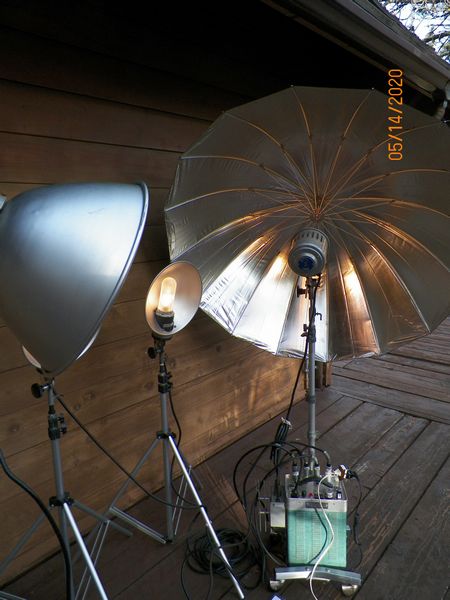
L-to-R: AA12SC, two AA11s, AA17L w/ umbr.
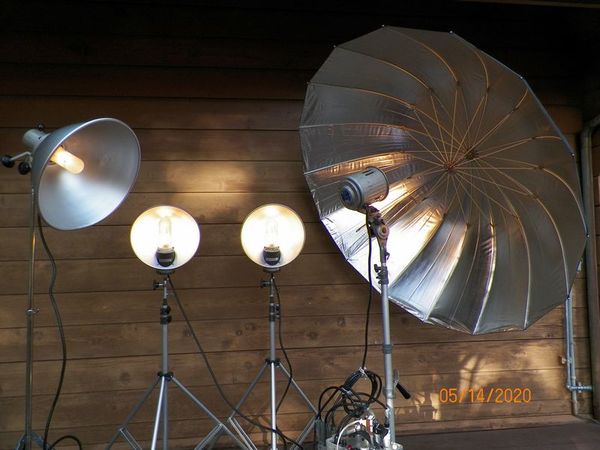
Salens 51R 16-rib 51" reflective umbrella
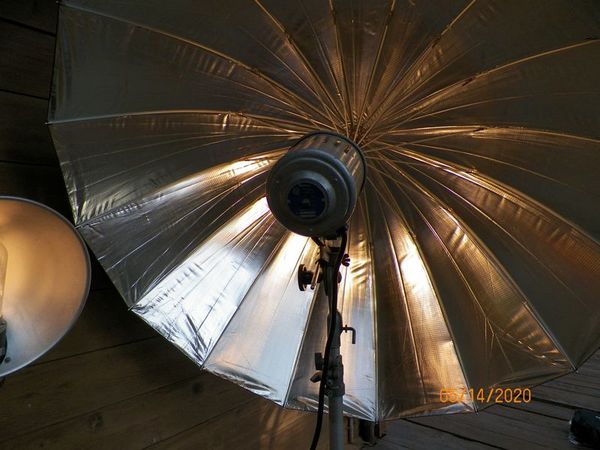
FlashMaster AA01 400 W-s supply and accessories
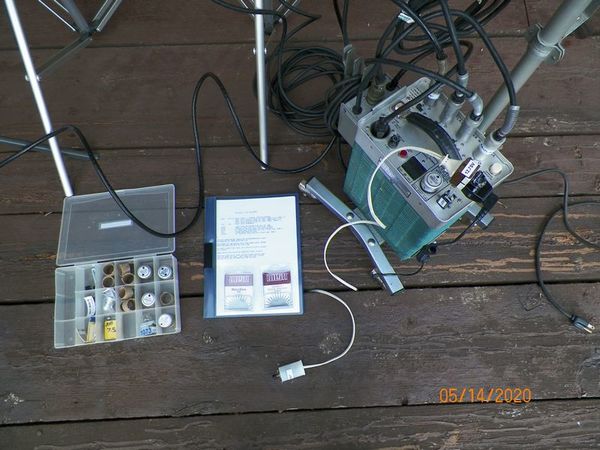
Trigger adapter, Wein L8 optical slave and Wein Safe-Sync
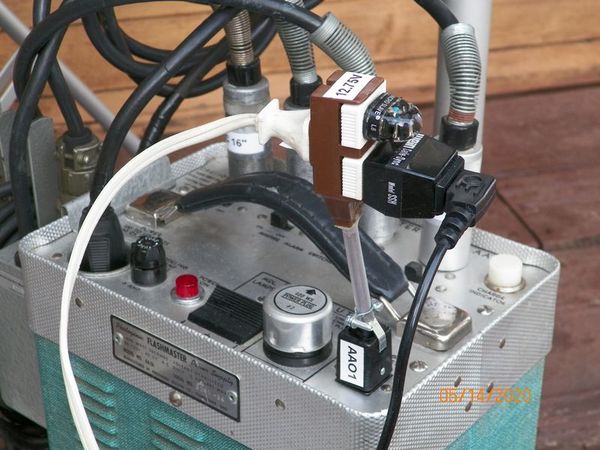
Mar 15, 2019 06:46:46 #
E. L. Shapiro was exactly right about how to trigger the flash.
Here are the pinouts using the pin numbers on the plug:
TRIGGER
OUTLET
2 1 |
.------. |
| == I | |
| == I | | Jack viewed from front panel
`------' |
4 3 |
------------------'
PIN
1. Ground (-)
2. ?
3. Hot +438 VDC (435 - 445 VDC)
4. Grid No. 1 (pin 1) in 212D gas thyristor tube (12.75 VDC)
Specs say Pin 4 can be between 12 - 15V. Mine measured 12.75V max.
Short pin 1 (Ground) to pin 4 (Grid No. 1 of 212D tube) to trigger flash.
High-voltage is present on pin 3 because this socket
was also used for a phototype optical slave.
Note that later FlashMaster models, beginning with the AA01A,
replaced the 21D gas thyristor tube with solid-state module
containing a Silicon Control Rectifier (SCR). I have heard
that a 8050PSA phototube for those models will not work with
the AA01.
INFORMATION OFFERED AS-IS. USE AT YOUR OWN RISK.
THIS UNIT CONTAINS DANGEROUS HIGH VOLTAGE THAT COULD BE FATAL.
Here are the pinouts using the pin numbers on the plug:
TRIGGER
OUTLET
2 1 |
.------. |
| == I | |
| == I | | Jack viewed from front panel
`------' |
4 3 |
------------------'
PIN
1. Ground (-)
2. ?
3. Hot +438 VDC (435 - 445 VDC)
4. Grid No. 1 (pin 1) in 212D gas thyristor tube (12.75 VDC)
Specs say Pin 4 can be between 12 - 15V. Mine measured 12.75V max.
Short pin 1 (Ground) to pin 4 (Grid No. 1 of 212D tube) to trigger flash.
High-voltage is present on pin 3 because this socket
was also used for a phototype optical slave.
Note that later FlashMaster models, beginning with the AA01A,
replaced the 21D gas thyristor tube with solid-state module
containing a Silicon Control Rectifier (SCR). I have heard
that a 8050PSA phototube for those models will not work with
the AA01.
INFORMATION OFFERED AS-IS. USE AT YOUR OWN RISK.
THIS UNIT CONTAINS DANGEROUS HIGH VOLTAGE THAT COULD BE FATAL.
If you want to reply, then register here. Registration is free and your account is created instantly, so you can post right away.



